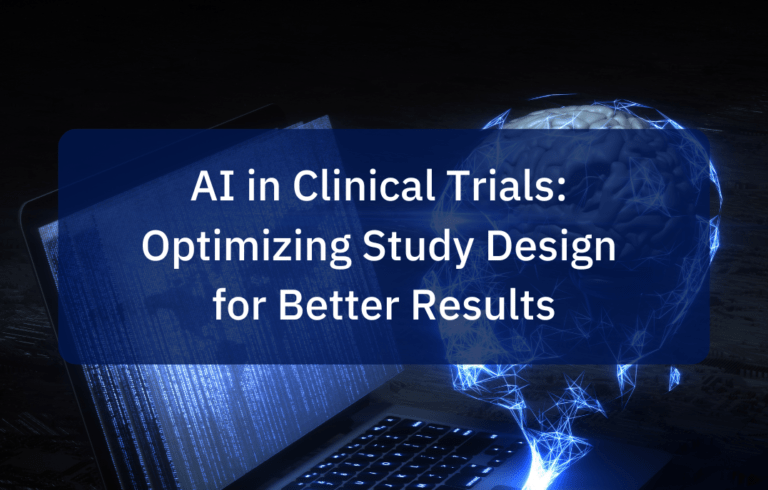
OUR SERVICE
AI’s Transformative Impact on Clinical Research
Although artificial intelligence technology is still developing, it has prompted a paradigm shift in clinical research. Machine learning (ML), a data-driven branch of AI that automates analytical model development, allows researchers to complete tasks more accurately and quickly. This, in turn, gives front-line healthcare personnel the power to treat patients effectively.
For many years, analytics have played a key role in healthcare decision-making. Historically, mathematical equations were used to describe recurring patterns in data. However, AI now enables scientists to uncover intricate correlations within datasets that traditional, equation-based statistical analysis cannot reveal. Unlike human doctors, data-rich computer algorithms can process enormous amounts of information with pinpoint precision. For instance, computer vision can outperform even the best expert human radiologists when analyzing a lung infected with TB, identifying in great detail the sizes of all TB granulomas and the location of any cavities within each lung. In the future, these algorithms will unlock new discoveries and correlations where they have not previously been observed.
Key figures in the healthcare industry are taking notice. The potential for AI to drastically reduce the financial burden of research by improving clinical decision-making and maximizing innovation is compelling. While many organizations are eager to embrace AI technology, it still needs to become more accessible for smaller companies. Data aggregation remains a significant challenge, and algorithms need to become more transparent and understandable to conform to the stringent rules of drug discovery. This essay explores how AI accelerates research, sparks innovation, and makes data analysis and drug discovery easier.
How Artificial intelligence is Used in the Drug Discovery and Development Process
Even though the term “artificial intelligence” is often used broadly, most people understand it to mean machine learning that can do tasks that usually require human intelligence. Tasks like seeing, hearing, making decisions, and translating languages typically define AI activity. Most AI implementations today are narrow in scope, solving only a few problems.
Artificial intelligence (AI) is typically used in the medical research industry for pattern recognition and data analysis in massive datasets. This data, analyzed significantly faster, more accurately, and more cost-effectively than with standard analytical procedures, can be used to cut costs and boost results. AI may also combine disparate datasets and sift through large amounts of scientific literature to uncover studies with practical use. According to the World Health Organization, cancer is the second leading cause of death worldwide and accounts for nearly 10 million deaths annually. Once a system has compiled and translated this massive amount of data into a common language, it could then apply machine-learning techniques to identify promising new cancer drugs. Such advances could significantly impact cancer treatments and even reduce cancer mortality rates.
AI’s Role in the Drug Discovery Approach
The U.S. Food and Drug Administration outlines five steps in the typical drug discovery approach:
Step 1: Discovery and Development – Research for a new drug begins in the laboratory.
Step 2: Preclinical Research – Drugs undergo laboratory and animal testing to answer basic questions about safety.
Step 3: Clinical Research – Drugs are tested on people to make sure they are safe and effective.
Step 4: FDA Review – FDA review teams thoroughly examine all submitted data related to the drug or device and decide whether to approve it.
Step 5: FDA Post-Market Safety Monitoring – FDA monitors safety once products are available for use by the public.
Companies can use AI in the first three phases of drug development to speed up and cut research and discovery costs. Let’s delve into the most significant applications of AI across the drug development life cycle.
Possible Drug Discovery Process
The preliminary phases of a drug discovery project are crucial. Possible applicants are screened at this point. In the early stages of drug discovery, high throughput screening (HTS) is the most common screening method. Integrating robotics and automation enables quick testing of large libraries of compounds.
How scientists find a chemical that helps patients:
- By gathering fresh information regarding disease mechanisms
- Molecular testing
- Investigating the unintended consequences of current therapies
- Using advanced methods of technology to handle genetic engineering
Patient Recruitment
The trial’s overall success depends on recruiting the correct patient population. It is the research team’s responsibility to select participants with the highest probability of benefiting from the treatment being examined. Modern healthcare IT uses artificial intelligence to help find patients and locations for trials.
Mainly, researchers use AI and ML algorithms to identify venues with the most extensive recruitment pool and to propose recruitment techniques. From demographic mapping to patient potential prediction, artificial intelligence and data analytics support the entire selection process.
Patients are matched with trials with the help of automated technologies that assess medical records and real-world evidence.
Patients Withdraw
Approximately 30% to 40% of participants will withdraw from a study at some point. Contrarily, after five months, 40% of patients are still non-adherent, which results in extra expenses for the pharmaceutical sector. The burdensome nature of patient reporting contributes to high attrition rates. Day-to-day data collection includes recording medication taken, body functioning, and other responses.
Regardless, developments in AI are assisting in enhancing patient retention and medicine compliance. When devices like smartwatches, sensors, fitness trackers, monitors and algorithms are used together, patient data can be automatically read and interpreted.
Clinical trial researchers can then receive immediate results from these deep learning models’ data analyses. Dropout risk prediction is another area where predictive analytics vendors can produce insightful models.
Real World Evidence
The field of RWE analytics examines the usefulness of drugs and medical procedures in actual clinical settings. The pharmaceutical business places a premium on this phenomenon because of its unrealized potential.
This vast trove of information in the medical field serves as a data blanket that can be used for a wide range of analytical purposes. New research paradigms for precision medicine can also be gained using RWE analytics.
Large data sets, including patient outcomes, collected through insurance claims, electronic health records, and other sources are essential for RWE’s cutting-edge analytics.
This information is then utilized to weigh the social benefits of medicine alongside its therapeutic benefits. Data analytics based on real-world evidence is widely recognized as an instrumental component of the drug development process, contributing to the safety and efficacy of treatments while keeping costs down.
Understanding the peculiarities of various patient populations is also a key takeaway from real-world evidence strategy and analytics.
However, tons of computational resources are needed to convert raw data into knowledge to develop real-world evidence. When this occurs, we can rely on artificial intelligence.
Machine learning is a cornerstone of RWE implementation. Intelligent algorithms can be used to generate crucial information to tackle problems that would otherwise take too much time and money to fix.
In particular, machine learning offers novel possibilities for consolidating disparate data sets into a single, authoritative repository. Analytics models can be executed constantly and at scale by tapping into connected data environments via algorithms.
Trial Data Analysis
Researchers face massive amounts of operational data during study wrap-up. However, data silos and isolated data architectures hide the vast majority of insights. For instance, developing a global trial portfolio takes a lot of work. Dispersed geo-based data is stored in isolated silos on local computers, making it infeasible to put into any analysis rapidly.
Analytics tools with artificial intelligence capabilities can centralize all relevant data and metrics. Algorithms do data cleansing and analysis on trial data and reporting tools display the results graphically to aid decision-making.
The new drug is sent to the FDA for a complete evaluation after undergoing extensive testing and development to ensure its optimal efficacy and safety. The FDA reviews the findings of clinical trials before deciding whether to approve the drug.
How can we incorporate real-world data into Drug development process?
RWE’s contributions can be found in every phase of the pharmaceutical industry. Researchers can only explore some feasible therapeutic combo due to a lack of time and money. When paired with automated processing, data analytics applied to evidence from the actual world becomes self-sufficient.
The FDA claims it uses RWE to monitor post-market safety and aid in regulatory decision-making. Healthcare practitioners frequently rely on strategy and analytics based on real-world evidence when making choices about coverage and developing health support tools for use in clinical practice.
Insights from RWE also provide a foundation for clinical trial designs and investigations, which pave the way for novel, data-driven treatment strategies.
Drug development difficulties with artificial intelligence
Acquiring Data
Intelligent systems live upon vast datasets to provide a high accuracy rate. Accordingly, the accessibility and quality of data are two pillars for implementing AI in drug research. Healthcare, however, is one of the sectors that has been hesitant to adopt AI. The main barriers are difficulties gaining access to the data, problems with regulations, and conflicts of interest.
In addition, there needs to be more statistical data because there are so few studies on rare disorders. This hinders scientists’ ability to amass enough information to train an AI algorithm adequately.
Data Evaluation
Disclosure of algorithms
Data privacy and availability
On the route to a unified data analytics pool, the availability of patient datasets is another obstacle. Even though they gather it, hospitals and clinics do not own patients’ personal information. Instead, they are tasked with working as data trustees who are bound to confidentiality.
In this case, the patient owns all of the information. Only with patient permission may data be shared. As a result, most data sets are confidential and cannot be shared for study.
In need of a trusted innovation partner to assist with AI-driven Drug development? Contact Us!
Conclusion
Are you falling behind in Drug Discovery because you are not utilizing AI’s capabilities?
Schedule a free consultation today to discuss how we can help you with these advancements!


AI in Clinical Trials: Optimizing Study Design for Better Results
